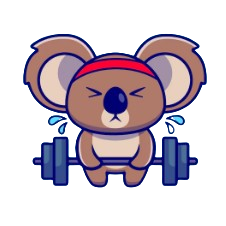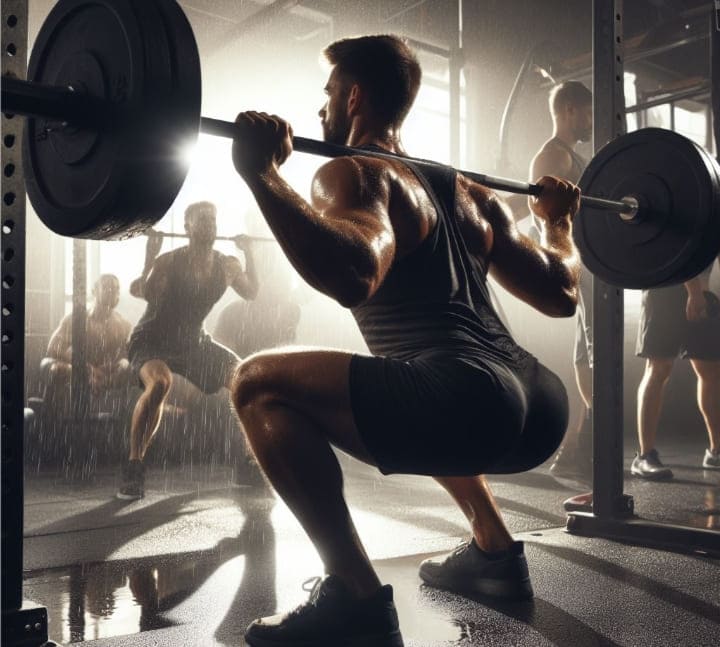Which Squat Exercises Are Ideal for Novices?
The squat is widely considered the most essential exercise for the lower body in the gym. However, for many individuals, the standard barbell squat can be quite intimidating. This is particularly true for beginners who may not yet feel comfortable loading significant weight onto their back and performing a deep squat. In this article, I will introduce six squat variations that offer similar advantages to the barbell squat and are suitable for newcomers.
Bodyweight Squat
How to Do it
- Stand with your feet shoulder width apart and your feet slightly pointed outward. Clasp your hands together in front of your body.
- Hinge at the hips and drop your butt back as you descend into a parallel squat position, where your thighs are parallel to the floor.
- Push through your heels to return to the start position.

Why it’s Good for Beginners
The bodyweight squat is the ideal introduction to the squat exercise as it only uses your body as the resistance. Not having to contend with additional resistance allows you to focus on correct form. Key form points are to maintain an upright torso with a neutral spine and move up and down in a smooth, piston-like manner.
The fact that this is a bodyweight only exercise makes it an ideal foundational move for your butt workouts at home.
Goblet Squat
How to Do it
- Stand with a kettlebell held in both hands against your chest. Feet should be shoulder width apart and pointed slightly outward.
- Maintaining an upright torso, drop your butt down and back as you descend to a parallel squat position.
- Push through your heels to return to the start position.

Why it’s Good for Beginners
The goblet squat is a logical advance from the bodyweight squat because it adds resistance without loading the spine. The resistance sits at the front of your torso. This, however, presents its own challenge. Many people tend to have an overly forward lean when they do this exercise, which leads to a rounding of the back. Having a coach check your form is recommended.
Barbell Back Squat to Box
How to Do it
- Place a twenty-four-inch box about eighteen inches from a squat rack.
- Load an empty barbell on a squat rack and set it at shoulder level.
- Get under the bar, with it resting across your trapezius and shoulders.
- Unrack the bar and take a step back.
- Looking directly ahead, hinge at the hips as you lower until your butt touches the box.
- Push through your heels to return to the start position.
Why it’s Good for Beginners
For many people, the scariest part of doing the barbell back squat is the thought of going down to the floor and not being able to get up again. As a result, many beginners stop way short of parallel on the descent. The box squat takes away the guesswork of the descent; you simply go down until your butt touches the box, then come back up again. This provides a sense of security and guidance that is a good stepping stone toward the traditional barbell back squat.
As a beginner, you should have an experienced person guiding your form when doing any version of the barbell squat.
Dumbbell Squat
How to Do it
- Stand with a pair of dumbbells held by your sides at arm’s length. Your feet should be shoulder width apart with your feet pointed slightly outward.
- Hinge at the hips to descend into a parallel squat. In the bottom position, the dumbbells should almost touch the floor.
- Push through the hills to return to the start position.

Why it’s Good for Beginners
The dumbbell squat allows you to load your quads and glutes without placing any load on your spine. It is also easier to get out of danger if you can’t complete a rep on this exercise; you simply drop the dumbbells to the floor.
Overhead Squat
How to Do it
- Load an empty barbell on a squat rack and set it at shoulder level.
- Take hold of the bar slightly wider than shoulder width with an overhand grip, unrack the bar, and rest it across your clavicles and front deltoids.
- Press the bar directly overhead and lock out your elbows.
- Hinge from the hips as you descend into a parallel squat position.
- Push through the heels to return to the start position.
Why it’s Good for Beginners
The overhead squat is a more complex exercise that allows you to load your entire body without directly loading the spine. This compound exercise should be done under expert guidance in order to properly recruit auxiliary muscles and ensure proper muscle alignment.
Pistol Squat
How to Do it
- Stand in front of a twenty-four-inch high box or a chair. Your feet should be shoulder width apart.
- Lift your left leg off the floor, straightening your leg out at an angle. Place your hands out to the sides for balance.
- Lower until your butt touches the box or chair.
- Return to the start position.
Why it’s Good for Beginners
The pistol squat is a challenging advance of the standard bodyweight squat that provides extra thigh load without having to load the spine. This is an exercise that requires a degree of balance and coordination. Once more, you should only do this exercise under expert guidance. I recommend checking out 1AND1YOU for a complete, top notch and affordable personal training service.
Resistance Bands
Resistance bands provide a great transition between bodyweight and free weight training. Doing squats with resistance bands allows for an increased load on the thighs without the spinal compression that may come from the free weight barbell squat. I personally use Crossover Symmetry Resistance Bands. They are the safest, most versatile, and best made bands I have come across.
https://www.youtube.com/embed/rQTBnvAhNsQ?feature=oembed9 Resistance Band Squat Variations – Set for Set
Conclusion
The squat is a fundamental compound exercise which should form part of your workout, whether you’re following a gym or home bodyweight workout plan. This article has provided you with a half dozen great beginner squat exercises that will develop your quads, glutes, and hamstrings. Experiment with each of them to see which ones work best for you. Then choose your favorite two and perform three to four sets of each, with rep ranges between eight and fifteen. Do this consistently for twelve weeks, and you’ll be ready to advance to the barbell back squat.



